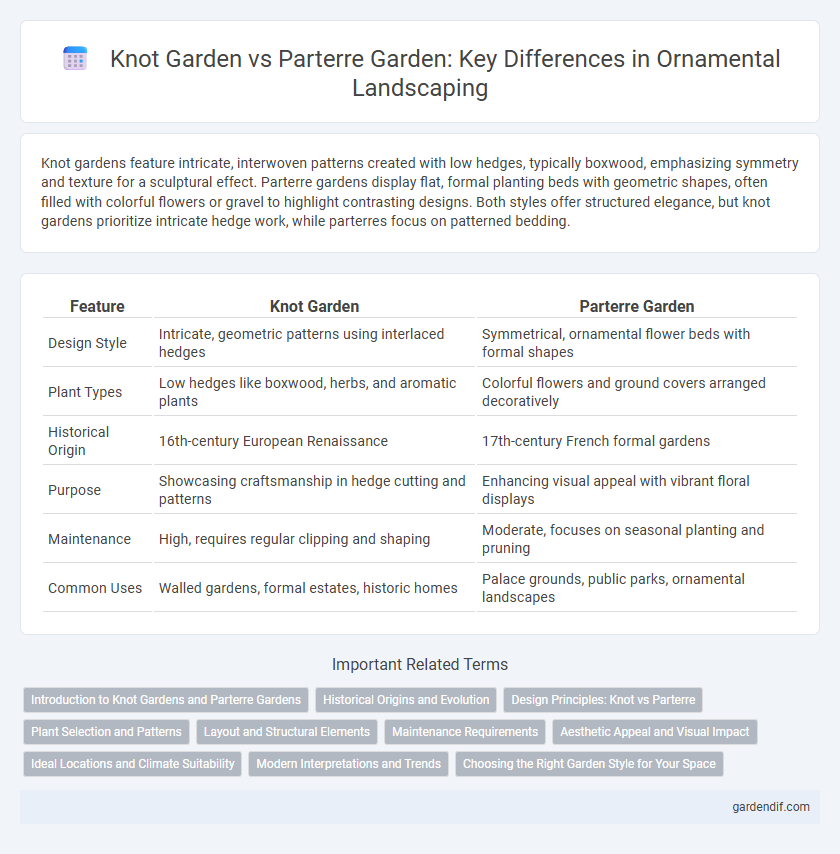
Knot Garden vs Parterre Garden Illustration
Knot gardens feature intricate, interwoven patterns created with low hedges, typically boxwood, emphasizing symmetry and texture for a sculptural effect. Parterre gardens display flat, formal planting beds with geometric shapes, often filled with colorful flowers or gravel to highlight contrasting designs. Both styles offer structured elegance, but knot gardens prioritize intricate hedge work, while parterres focus on patterned bedding.
Table of Comparison
| Feature | Knot Garden | Parterre Garden |
|---|---|---|
| Design Style | Intricate, geometric patterns using interlaced hedges | Symmetrical, ornamental flower beds with formal shapes |
| Plant Types | Low hedges like boxwood, herbs, and aromatic plants | Colorful flowers and ground covers arranged decoratively |
| Historical Origin | 16th-century European Renaissance | 17th-century French formal gardens |
| Purpose | Showcasing craftsmanship in hedge cutting and patterns | Enhancing visual appeal with vibrant floral displays |
| Maintenance | High, requires regular clipping and shaping | Moderate, focuses on seasonal planting and pruning |
| Common Uses | Walled gardens, formal estates, historic homes | Palace grounds, public parks, ornamental landscapes |
Introduction to Knot Gardens and Parterre Gardens
Knot gardens are intricate ornamental designs featuring interlaced, clipped evergreen hedges, typically boxwood, arranged in symmetrical, geometric patterns inspired by Renaissance and Tudor garden styles. Parterre gardens emphasize flat beds with ornamental patterns created through low hedges, often filled with colorful flowers, gravel, or turf, offering a highly structured and visually striking landscape. Both garden types serve as formal, decorative elements in landscape architecture, reflecting meticulous craftsmanship and historical European influences.
Historical Origins and Evolution
Knot gardens originated in the 16th century during the Tudor period in England, characterized by intricate, interlaced hedges meant to resemble woven patterns, often using boxwood or herbs. Parterre gardens evolved in the 17th century in France, designed with formal, symmetrical patterns laid out in gravel beds and edged with low clipped hedges to create ornamental layouts visible from above. Both garden styles reflect Renaissance influences but differ in their cultural and design evolution, with knot gardens emphasizing intricate herbaceous patterns and parterres focusing on grand, formal geometry.
Design Principles: Knot vs Parterre
Knot gardens emphasize intricate interlacing patterns created with low hedges, focusing on geometric shapes and symmetry to produce a visually complex yet orderly design. Parterre gardens prioritize broad, flat layouts with symmetrical beds separated by gravel pathways, combining colorful plantings and precise edging to highlight contrast and balance. Both styles rely heavily on structured principles of geometry and order, but knot gardens showcase tightly woven designs while parterres emphasize spacious, patterned displays.
Plant Selection and Patterns
Knot gardens feature evergreen herbs like thyme, rosemary, and boxwood carefully trimmed into intricate, geometric patterns that emphasize texture and form. Parterre gardens use a broader variety of flowering plants such as begonias, geraniums, and petunias, arranged in elaborate, colorful designs that highlight vibrant seasonal blooms. Both styles rely on precise plant placement, but knot gardens prioritize symmetry and evergreen structure while parterres focus on ornamentation through vivid floral displays.
Layout and Structural Elements
Knot gardens feature intricate, interlaced patterns created with low hedges or clipped boxwood, emphasizing geometric designs and symmetry in compact spaces. Parterre gardens display broader, formal layouts with ornamental flower beds separated by gravel pathways, often incorporating decorative elements like fountains or statues. Both styles prioritize precise structural elements, but knot gardens focus more on detailed hedge work, while parterres highlight colorful plant groupings and expansive spatial organization.
Maintenance Requirements
Knot gardens demand meticulous maintenance with frequent trimming and pruning to preserve their intricate geometric patterns, often requiring skilled gardeners to maintain their crisp, interwoven designs. Parterre gardens involve regular upkeep of low hedges and ornamental flower beds, focusing on symmetry and seasonal planting rotations to ensure vibrant, year-round appeal. Both styles require consistent weeding and soil care, but knot gardens emphasize precision in hedge shaping while parterre gardens prioritize floral diversity and color coordination.
Aesthetic Appeal and Visual Impact
Knot gardens feature intricate, interlaced patterns of low hedges, often boxwood, creating a textured, three-dimensional appearance that emphasizes geometric precision and historical charm. Parterre gardens showcase flat, ornamental flower beds with symmetrical designs outlined by gravel or pathways, amplifying color contrast and seasonal floral displays for a vibrant visual impact. Both garden styles enhance aesthetic appeal through structured layouts, but knot gardens emphasize texture and form, whereas parterres prioritize color and pattern.
Ideal Locations and Climate Suitability
Knot gardens thrive in temperate climates with well-drained soil, ideally suited for formal courtyards or enclosed spaces where their intricate patterns can be fully appreciated. Parterre gardens perform best in sunny locations with consistent moisture, often found in large estate grounds that accommodate their expansive, symmetrical layouts. Both garden styles benefit from environments that support the growth of low hedges like boxwood, ensuring precise geometric shapes and year-round visual interest.
Modern Interpretations and Trends
Modern interpretations of knot gardens emphasize geometric precision using low hedges like boxwood, integrating drought-tolerant plants for sustainability and minimalist aesthetics. Parterre gardens have evolved with contemporary materials and colorful flowerbeds, highlighting vibrant patterns and incorporating edible plants to blend beauty with utility. Trends favor combining traditional formal layouts with innovative plant selections and eco-friendly design principles.
Choosing the Right Garden Style for Your Space
Knot gardens feature intricately woven patterns of low hedges, typically boxwood, offering a formal and historical aesthetic ideal for smaller, structured spaces. Parterre gardens showcase symmetrical beds with colorful plants and gravel pathways, creating a more expansive, decorative design that suits larger outdoor areas. Selecting the right garden style depends on the available space, desired maintenance level, and the overall ornamental effect you want to achieve.
Knot Garden vs Parterre Garden Infographic

 gardendif.com
gardendif.com